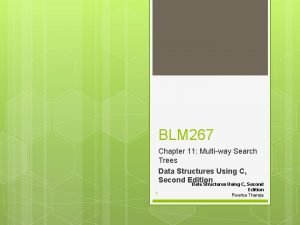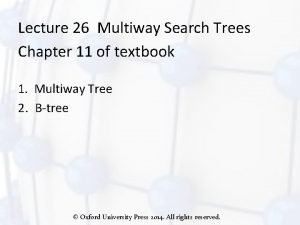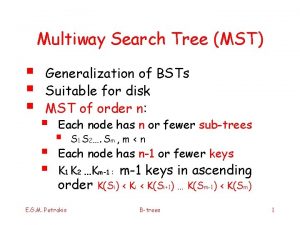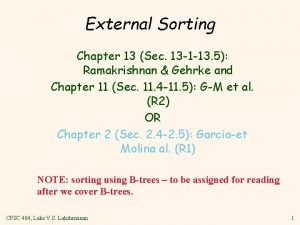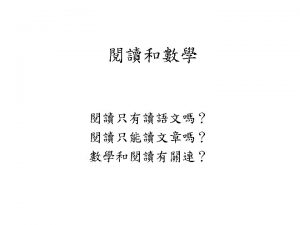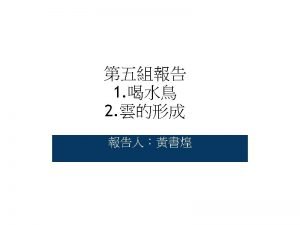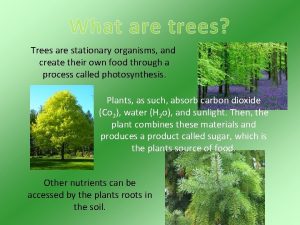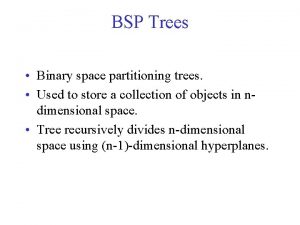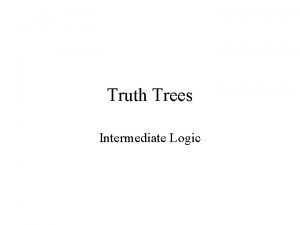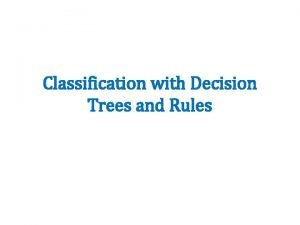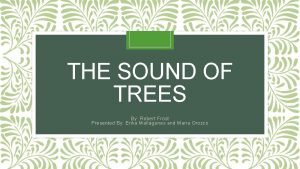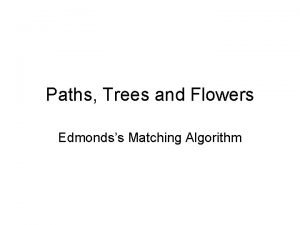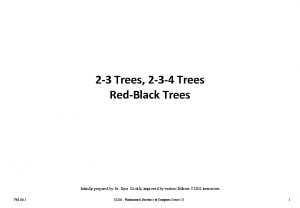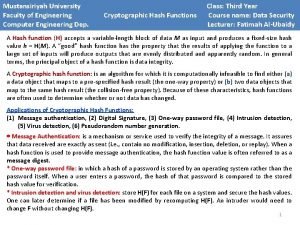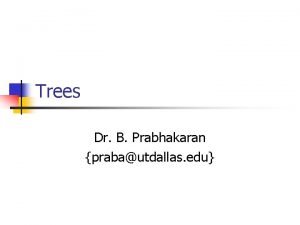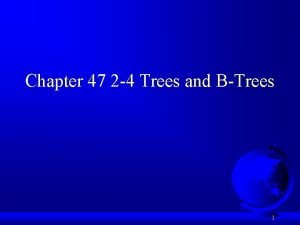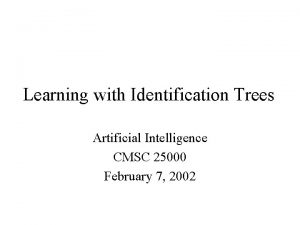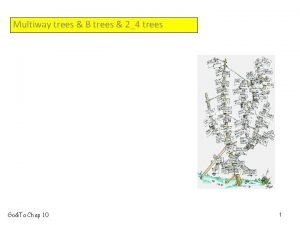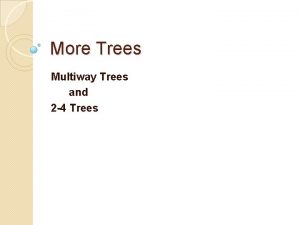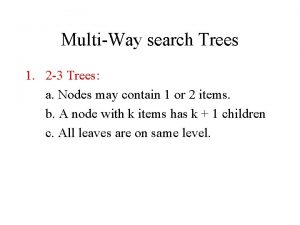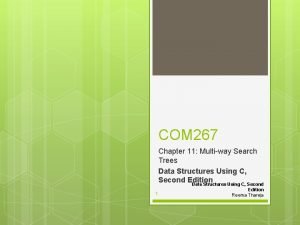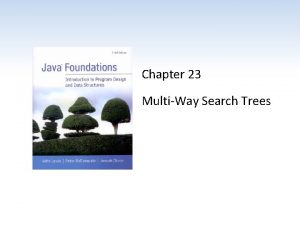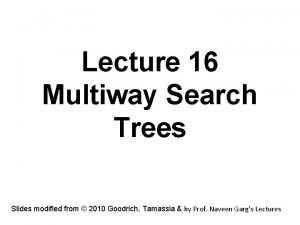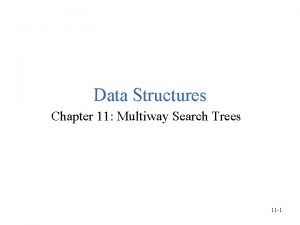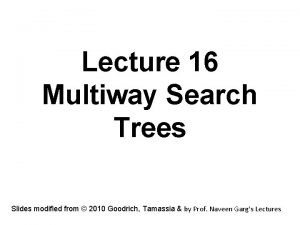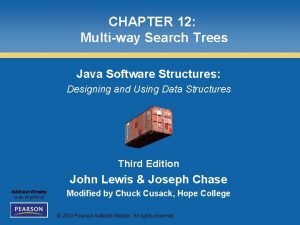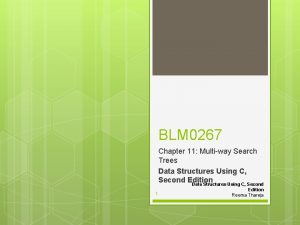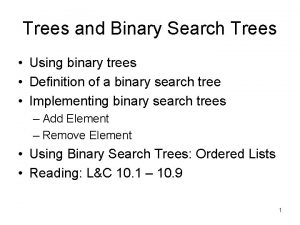MultiWay search Trees 1 2 3 Trees a































































- Slides: 63

Multi-Way search Trees 1. 2 -3 Trees: a. Nodes may contain 1 or 2 items. b. A node with k items has k + 1 children c. All leaves are on same level.

Example • A 2 -3 tree storing 18 items. 20 80 30 70 5 2 4 10 25 40 50 75 90 100 85 95 110 120

Updating • Insertion: • Find the appropriate leaf. If there is only one item, just add to leaf. • Insert(23); Insert(15) • If no room, move middle item to parent and split remaining two item among two children. • Insert(3);

Insertion • Insert(3); 20 80 5 2 3 4 10 15 30 70 23 25 40 50 75 90 100 85 95 110 120

Insert(3); • In mid air… 20 80 5 30 70 90 100 3 2 4 10 15 23 25 40 50 75 85 95 110 120

Done…. 20 80 3 5 2 30 70 4 10 15 23 25 40 50 75 90 100 85 95 110 120

Tree grows at the root… • Insert(45); 20 80 3 5 2 4 30 70 10 25 40 45 50 75 90 100 85 95 110 120

• New root: 45 20 3 5 2 4 80 30 10 25 40 70 50 90 100 75 85 95 110 120

Delete • If item is not in a leaf exchange with inorder successor. • If leaf has another item, remove item. • Examples: Remove(110); • (Insert(110); Remove(100); ) • If leaf has only one item but sibling has two items: redistribute items. Remove(80);

Remove(80); • Step 1: Exchange 80 with in-order successor. 45 20 3 5 2 4 85 30 10 25 40 70 50 90 100 75 80 95 110 120

• Redistribute. Remove(80); 45 20 3 5 2 4 85 30 10 25 40 70 50 95 110 75 90 100 120

Some more removals… • Remove(70); Swap(70, 75); Remove(70); “Merge” Empty node with sibling; Join parent with node; Now every node has k+1 children except that one node has 0 items and one child. Sibling 1 110 can spare an item: redistribute.

Delete(70) 45 20 3 5 2 4 85 30 10 25 40 75 50 95 110 90 100 120

New tree: • Delete(75) will “shrink” the tree. 45 20 3 5 2 4 95 30 10 75 25 40 50 110 90 100 120

Details • • • 1. Swap(75, 90) //inorder successor 2. Remove(75) //empty node created 3. Merge with sibling 4. Drop item from parent// (50, 90) empty Parent 5. Merge empty node with sibling, drop item from parent (95) • 6. Parent empty, merge with sibling drop item. Parent (root) empty, remove root.

“Shorter” 2 -3 Tree 20 45 3 5 2 4 30 10 25 40 95 110 50 90 100 120

Deletion Summary • If item k is present but not in a leaf, swap with inorder successor; • Delete item k from leaf L. • If L has no items: Fix(L); • Fix(Node N); • //All nodes have k items and k+1 children • // A node with 0 items and 1 child is possible, it will have to be fixed.

Deletion (continued) • If N is the root, delete it and return its child as the new root. • Example: Delete(8); 5 5 1 3 2 8 3 3 Return 35 35

Deletion (Continued) • If a sibling S of N has 2 items distribute items among N, S and the parent P; if N is internal, move the appropriate child from S to N. • Else bring an item from P into S; • If N is internal, make its (single) child the child of S; remove N. • If P has no items Fix(P) (recursive call)

(2, 4) Trees • Size Property: nodes may have 1, 2, 3 items. • Every node, except leaves has size+1 children. • Depth property: all leaves have the same depth. • Insertion: If during the search for the leaf you encounter a “full” node, split it.

(2, 4) Tree 10 3 8 45 25 60 50 55 70 90 100

Insert(38); 45 10 3 8 25 38 60 50 55 70 90 100

Insert(105) • Insert(105); 45 10 3 8 25 38 60 90 50 55 70 105

Removal • As with BS trees, we may place the node to be removed in a leaf. • If the leaf v has another item, done. • If not, we have an UNDERFLOW. • If a sibling of v has 2 or 3 items, transfer an item. • If v has 2 or 3 siblings we perform a transfer

Removal • If v has only one sibling with a single item we drop an item from the parent to the sibling, remove v. This may create an underflow at the parent. We “percolate” up the underflow. It may reach the root in which case the root will be discarded and the tree will “shrink”.

Delete(15) 35 20 6 60 15 40 50 70 80 90

Delete(15) 35 20 6 60 40 50 70 80 90

Continued • Drop item from parent 35 60 6 20 40 50 70 80 90

Fuse 35 60 6 20 40 50 70 80 90

Drop item from root • Remove root, return the child. 35 60 6 20 40 50 70 80 90

Summary • Both 2 -3 tress and 2 -4 trees make it very easy to maintain balance. • Insertion and deletion easier for 2 -4 tree. • Cost is waste of space in each node. Also extra comparison inside each node. • Does not “extend” binary trees.

Red-Black Trees • Root property: Root is BLACK. • External Property: Every external node is BLACK • Internal property: Children of a RED node are BLACK. • Depth property: All external nodes have the same BLACK depth.

Red. Black Insertion

Red Black Trees, Insertion 1. Find proper external node. 2. Insert and color node red. 3. No black depth violation but may violate the red-black parent-child relationship. 4. Let: z be the inserted node, v its parent and u its grandparent. If v is red then u must be black.

Color adjustments. • Red child, red parent. Parent has a black sibling. a b u w v z Vl Zl Zr

Rotation • Z-middle key. Black height does not change! No more red-red. a b z u v Vl Zl Zr w

Color adjustment II a b u w v Vr z Zl Zr

Rotation II a b v u z Zl Zr Vr w

Recoloring • Red child, red parent. Parent has a red sibling. a b u w v z Vl Zr

Recoloring • Red-red may move up… a b u w v z Vl Zl Zr

Red Black Tree • Insert 10 – root 10

Red Black Tree • Insert 10 – root 10

Red Black Tree • Insert 85 10 85

Red Black Tree • Insert 15 10 85 15

Red Black Tree • Rotate – Change colors 15 10 85

Red Black Tree • Insert 70 15 10 85 70

Red Black Tree • Change Color 15 10 85 70

Red Black Tree • Insert 20 15 10 85 70 20

Red Black Tree • Rotate – Change Color 15 10 70 20 85

Red Black Tree • Insert 60 15 10 70 85 20 60

Red Black Tree • Change Color 15 10 70 85 20 60

Red Black Tree • Insert 30 15 10 70 85 20 60 30

Red Black Tree • Rotate 15 10 70 85 30 20 60

Red Black Tree • Insert 50 15 10 70 85 30 20 60 50

Red Black Tree • Insert 50 15 10 70 85 30 20 Oops, red-red. ROTATE! 60 50

Red Black Tree • Double Rotate – Adjust colors 30 15 10 Child-Parent-Gramps Middle goes to “top Previous top becomes child. 70 20 60 50 85

Red Black Tree • Insert 65 30 15 10 70 20 85 60 50 65

Red Black Tree • Insert 80 30 15 10 70 20 85 60 50 65 80

Red Black Tree • Insert 90 30 15 10 70 20 85 60 50 65 80 90

Red Black Tree • Insert 40 30 15 10 70 20 85 60 50 40 65 80 90

Red Black Tree • Adjust color 30 15 10 70 20 85 60 50 40 65 80 90

Red Black Tree • Insert 5 30 15 10 70 20 85 60 5 50 40 65 80 90

Red Black Tree • Insert 55 30 15 10 70 20 85 60 5 50 40 65 55 80 90
 Multiway trees
Multiway trees B tree insertion example
B tree insertion example 105 ×106
105 ×106 Two way selection and multiway selection in c
Two way selection and multiway selection in c Mapreduce شرح
Mapreduce شرح Multiway selection in c
Multiway selection in c Two phase multiway merge sort
Two phase multiway merge sort Repetition flowchart examples
Repetition flowchart examples Pentaho multiway merge join
Pentaho multiway merge join Multiway trie
Multiway trie Time complexity of ternary search
Time complexity of ternary search Binary search trees
Binary search trees Benefits of binary search
Benefits of binary search Federated search vs distributed search
Federated search vs distributed search Local search vs global search
Local search vs global search Which search strategy is called as blind search
Which search strategy is called as blind search Blind search dan heuristic search
Blind search dan heuristic search Linear search vs binary search
Linear search vs binary search What is informed search and uninformed search
What is informed search and uninformed search 1http
1http Video.search.yahoo.com
Video.search.yahoo.com Which search strategy is also called as blind search?
Which search strategy is also called as blind search? Http://tw
Http://tw Https://images.search.yahoo.com
Https://images.search.yahoo.com Yahoo search videos
Yahoo search videos Unified search vs federated search
Unified search vs federated search Semantic search vs cognitive search
Semantic search vs cognitive search Best first search in ai
Best first search in ai What are trees
What are trees Fat trees
Fat trees Bsp binary space partition
Bsp binary space partition Truth tree branching rules
Truth tree branching rules The bean trees quiz
The bean trees quiz Biotic and abiotic factors definition
Biotic and abiotic factors definition Monkeys live in or on trees
Monkeys live in or on trees Pink
Pink An example of a parallel choice on a dichotomous key is .
An example of a parallel choice on a dichotomous key is . Figurative language
Figurative language A free bird leaps
A free bird leaps The trees by philip larkin
The trees by philip larkin Trees upenn
Trees upenn Density estimation trees
Density estimation trees Trees sound
Trees sound Expression trees
Expression trees Taiga location
Taiga location Binary index tree
Binary index tree Paths, trees, and flowers
Paths, trees, and flowers 2-3 trees
2-3 trees Tree diagrams worksheet
Tree diagrams worksheet Food chain with 5 trophic levels
Food chain with 5 trophic levels Trees in korea
Trees in korea Trashketball rules
Trashketball rules The wild swans at coole poetic techniques
The wild swans at coole poetic techniques Which of the following graphs are trees
Which of the following graphs are trees 2-4 trees
2-4 trees Examples of biotic components
Examples of biotic components Create a cladogram of five indoor plants
Create a cladogram of five indoor plants The trees philip larkin
The trees philip larkin Tep trees
Tep trees Identification trees ai
Identification trees ai Song of the trees questions and answers
Song of the trees questions and answers Trees living or nonliving
Trees living or nonliving The house on mango street chapter 1
The house on mango street chapter 1 Battling over clayoquot big trees worksheet answers
Battling over clayoquot big trees worksheet answers
